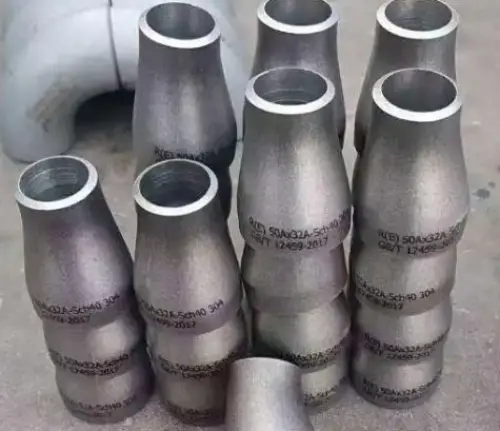Concentric reducers are a common pipe connector, primarily used for transitional connections between pipes of different diameters. Their structural characteristic is that the diameters at both ends differ, but their centerlines coincide, hence the name "concentric reducer." In industrial piping systems, connecting pipes of different diameters is often necessary due to process requirements or space constraints, and concentric reducers play an important role in these situations.
Concentric reducers are manufactured from a variety of materials, including carbon steel, stainless steel, and alloy steel. The specific choice depends on the nature of the pipeline's transport medium and the operating environment. For example, stainless steel reducers are often used when transporting corrosive media, while alloy steel reducers are more suitable for high-temperature and high-pressure environments. Concentric reducers are typically manufactured using methods such as seamless steel pipe rolling, steel plate welding, or forging to ensure their strength and sealing properties meet operational requirements.

Concentric reducers are manufactured from a variety of materials, including carbon steel, stainless steel, and alloy steel. The specific choice depends on the nature of the pipeline's transport medium and the operating environment. For example, when conveying corrosive media, stainless steel reducers are often chosen; however, alloy steel reducers are more suitable for high-temperature and high-pressure environments. In terms of manufacturing processes, concentric reducers are typically manufactured using methods such as seamless steel pipe rolling, steel plate welding, or forging to ensure their strength and sealing properties meet operational requirements.
Concentric reducers have a wide range of applications and are commonly found in industries such as petroleum, chemical, power generation, shipbuilding, and construction. In the petrochemical industry, piping systems often need to transport media with varying flow rates, and reducers provide a smooth transition and reduce fluid resistance. In building water supply and drainage systems, reducers are used to connect pipes of different specifications to accommodate spatial layout requirements. In shipbuilding, due to limited space within cabins, reducers can optimize pipe routing and improve space utilization.
The counterpart to concentric reducers is eccentric reducers, differing in whether their centerlines coincide. Eccentric reducers have one end with its centerline offset from the other, primarily used in applications where maintaining a flush bottom or top is crucial, such as preventing liquid accumulation in drainage pipes. Concentric reducers, on the other hand, are suitable for applications requiring smooth media flow, such as pump inlet and outlet connections.
When selecting a concentric reducer, factors such as the diameter variation range, media characteristics, operating pressure, and temperature should be comprehensively considered. Generally speaking, the diameter variation should be minimal, as this may lead to unstable fluid flow, vortices, or shock. The reducer length should also be appropriately designed. Too short a diameter may result in an awkward transition, while too long a diameter may increase unnecessary space and material costs.
1. Concentric reducers are essential components for connecting pipes of different diameters. Their characteristic feature is that the diameters at both ends differ, but the centerlines coincide.
2. Materials include carbon steel, stainless steel, and alloy steel. The media properties and operating environment should be considered when selecting a concentric reducer.
3. During installation, attention should be paid to alignment, welding quality, and pressure-bearing capacity to ensure the stability and safety of the piping system.











